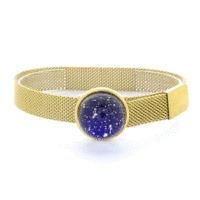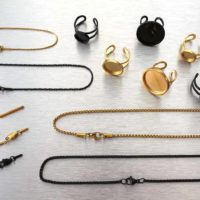Dichroic glass: the art of changing colors
The world of artistic materials is full of mysteries and innovations, and dichroic glass is a perfect example. This enigmatic term, derived from the Greek “διχροος” (dikhroos) meaning “two-tone”, conceals a fascinating technology developed by the space industry. A few decades later, the process was applied to glass and won the hearts of glassmakers and artists alike. In this article, we delve into the world of dichroic glass, its origins, its complex manufacture and its infinite possibilities for designers.
The magic of dichroic glass in my jewelry
Dichroic glass takes its name from its unique visual effect: the coexistence of two distinct colors, one transparent and the other reflective. This chromatic dance changes with the viewing angle and varies according to the frequency of the light, whether natural or artificial. The effect is simply magical, offering an unprecedented palette of changing colors.
NASA research
The origins of dichroic glass date back to the 1950s/1960s, when NASA developed this technology for the space industry to protect astronauts and equipment from the effects of cosmic radiation and solar intensity. Satellite dishes, for example, are treated in this way, as are the visors on astronauts’ helmets …
Popularization by CBS
In the mid-90s, the American company CBS, Coating By Sandberg, applied this technique to glass on a large scale. Dichroic glass was born and made available to craftsmen and glass artists.
An astonishing manufacturing process
The creation of dichroic glass is a veritable technical tour de force. A multi-layer coating is deposited on the glass using a highly specialized process. Quartz crystal and various metals and metal oxides, including gold, titanium, chromium, aluminum, zinc, copper, magnesium and many others, are vaporized in a vacuum chamber using an electron beam gun. Metals and oxides are micronized, and the resulting vapor condenses and attaches to the glass surface in the form of a crystalline structure. Up to 30 coats are applied, for a total thickness of one to two microns. In addition to its captivating visual properties, dichroic glass stands out for its durability. In fact, this coating is extremely hard and almost scratchproof, with a hardness comparable to that of diamond.
Endless possibilities for craftsmen and artists
CBS dichroic glass is designed for hot working, whether fusing, glass paste or flameworking for beadmaking. This versatility opens up vast creative horizons for artisans, enabling them to explore a variety of techniques and express their artistic vision in unique ways.
Discover my story as a glass artisan, from sculptures to jewelry.









